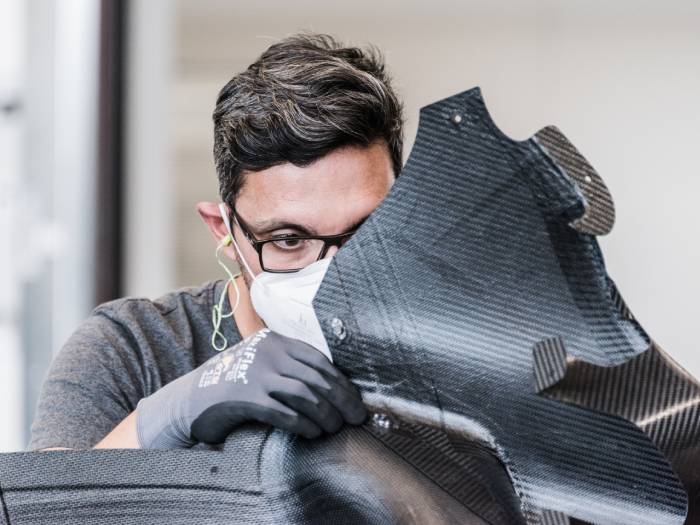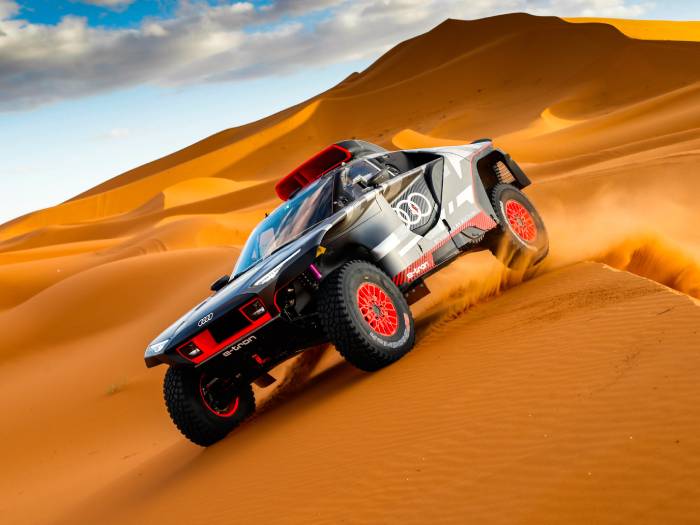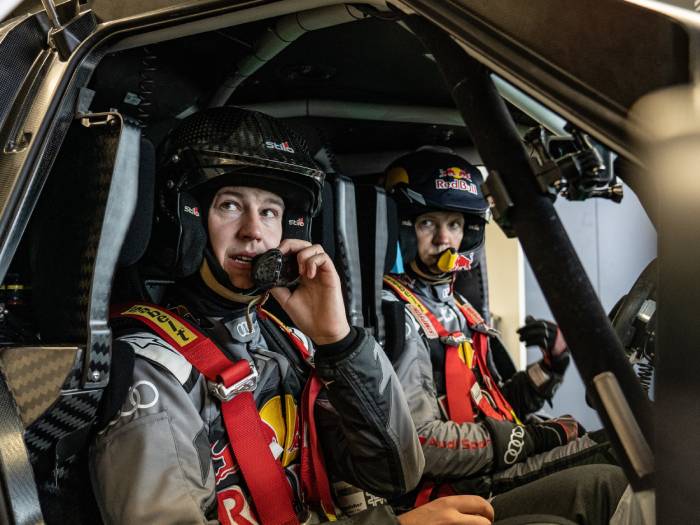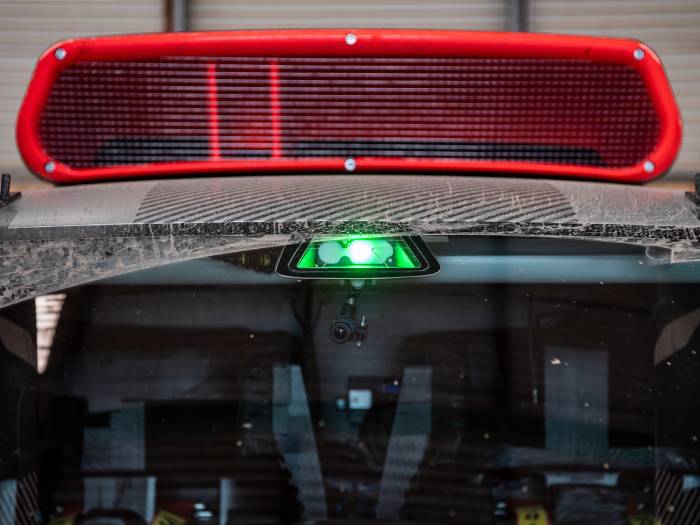Safety and performance: Audi RS Q e-tron for the Dakar Rally
The Audi RS Q e-tron is ready to compete in the upcoming Dakar Rally: the innovative electric prototype with range extender has an advanced safety concept covering every aspect of the vehicle, from the passenger compartment to the battery and the high-voltage system.
The Audi RS Q e-tron will make its debut at the upcoming Dakar Rally that will be held between January 2 and 14, 2022, bringing a cutting-edge technical concept to rally raids for the first time. The innovative electric prototype with range extender has an electric powertrain derived from the Audi e-tron FE07 Formula E: two MGUs (Motor Generator Units), one at each axle, provide traction, while a third unit acts as a generator to help recharge the high-voltage battery, especially under braking.
Since it is not possible to draw energy in the desert, Audi has opted for an onboard solution: while the vehicle is in motion, the high-voltage battery is charged by an energy converter – consisting of the efficient TFSI engine from the DTM championship.
A complex project
From the very beginning of the prototype's design, safety was the main focus, to ensure the highest standards in all conditions, even the most extreme ones typical of off-road racing and in particular of the world's most difficult rally raid. There were many challenges: from the safety of the entire electrical system to the optimal protection of the driver and co-driver.
The Audi RS Q e-tron chassis

The protective and load-bearing basic structure of the Audi RS Q e-tron consists of a tube frame, which is required by law to be made of metallic materials. Audi's engineers chose heat-resistant, alloyed quenched and tempered steel from the aerospace industry that contains the alloying elements chromium, molybdenum and vanadium (CrMoV). As a result, the tube frame complies with the geometry defined in the regulations and fulfills the required static pressure tests.
The drivers are protected by panels of CFRP - carbon fiber mixed with thermoplastic polyurethane - which are inserted into the interstices of the frame and in some cases are reinforced with Zylon, a thermosetting polymer that prevents the penetration of sharp and pointed objects, while protecting drivers and co-drivers from any problems with the high-voltage system.
Safety in motorsport

Axel Löffler, Chief Designer Audi RS Q e-tron, explains: “The structural design of the frame incorporated methods and findings that we have honed over decades in many disciplines”. Audi is one of the very few manufacturers to have been involved in such a wide range of top-level sporting programmes, always using cutting-edge solutions: from the tubular frame for the DTM (2004-2011), the sheet-steel chassis in rallycross (2017-2018), the CFRP monocoques of the Endurance prototypes that won the Le Mans 24 Hours (1999-2016), the most recent DTM cars (2012-2020) and the Formula E single-seaters (2017-2021).
Audi's motorsport expertise extends to the entire design of the RS Q e-tron: CFRP and Kevlar or a mix of the two materials, in some areas with a honeycomb structure, were used for the various body parts.
Glass and polycarbonate: attention to every detail
The laminated glass windshield, which has undergone a special anti-scratch treatment, is derived from that of the Audi A4, while the side windows are made of lighter polycarbonate. The view from inside is very wide and the couplings between the glass surfaces and the bodywork are sealed with foam material against dust.
Finally, the seats also have shells made of CFRP, with a design similar to that of the DTM and Endurance cars, the only difference being the deformation-controlled section at shoulder height required by the regulations. The shells are identical for all crews, while the pneumatic cushions and foam inserts are custom-made for maximum comfort.
Safety for the battery

The high-voltage system requires a high level of protection. The high-voltage battery is located in the central part of the car and is encapsulated in an enclosure made of CFRP and Zylon. The underbody, on the other hand, is the most "critical" area of the car, because in rally raids it is exposed to extreme stress: jumps, boulders, stones and various obstacles bounce underneath the RS Q e-tron. Thus, the outermost layer consists of an aluminium plate, which resists abrasion and absorbs some of the energy of impacts, accompanied by a layer of expanded foam that absorbs energy and distributes it to the sandwich structure above.
The latter (also made of CFRP) protects the battery and the fuel tank of the energy converter by performing two tasks: it absorbs the surface load transmitted from the aluminium plate via the foam and deforms in a controlled manner, protecting the battery, when this load is excessive. This protective component, which is 54 mm thick, can be quickly replaced during end-of-stage service. “Projects like this allow us to transfer the knowledge gained on the circuit to cross-country rallying; the stresses to which the chassis and underbody are subjected are similar. The suspension is different, of course, but the g-forces we measure are similar to those of the Le Mans prototypes”, adds Axel Löffler.
A complete safety system

The ISO monitor, which detects fault currents, is also derived from Endurance prototypes and Formula E cars. If an accident occurs and a kinetic load above the threshold is detected, the entire system automatically switches off, while at the same time an acoustic signal and body lights warn emergency services of the danger. The system is also insulated against water, so the RS Q e-tron can safely cross fords. In the event of a fire, however, the extinguishing system uses an electrically inert agent. The entire team, including drivers and navigators, and the rescue services have been trained to handle high-voltage.
Special systems
The Dakar organisation provides all participants with an automatic SOS system that includes satellite tracking of the vehicles, a camera in the cockpit to check what is happening on board in real time, and a 'black box' to reconstruct and analyse what happened. Then there is the Sentinel system (compulsory for all vehicles), which warns the driver if a faster vehicle is coming, to improve overtaking safety, especially in dusty conditions. The maximum speed in the T1 category is limited to 170 km/h. With this holistic approach, Audi confirms its role as a pioneer of safety also in motorsport.
Source: AUDI AG
VGI | Responsible OU: VP | Creation date: article date | Class 9.1
